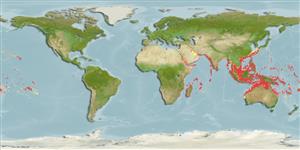>
Eupercaria/misc (Various families in series Eupercaria) >
Lethrinidae (Emperors or scavengers) > Monotaxinae
Etymology: Gymnocranius: Greek, gymnos = naked + Greek, kranion = skull (Ref. 45335).
More on author: Valenciennes.
Environment: milieu / climate zone / depth range / distribution range
Ecologia
marinhas associadas(os) a recifes; não migratória; intervalo de profundidade 20 - 170 m (Ref. 12260). Tropical; 35°N - 28°S, 32°E - 134°W
Indo-Pacific: East Africa to southeastern Oceania and from Australia northward to Japan. This species has been referred to as Gymnocranius robinsoni in recent literature.
Tamanho / Peso / Idade
Maturity: Lm ? range ? - ? cm
Max length : 80.0 cm TL macho/indeterminado; (Ref. 2295); common length : 64.0 cm SL macho/indeterminado; (Ref. 37816); peso máx. Publicado: 5.5 kg (Ref. 40637)
Espinhos dorsais (total) : 10; Raios dorsais moles (total) : 10; Espinhos anais: 3; Raios anais moles: 10.
Inhabits offshore reefs (Ref. 9710), trawling grounds of the continental shelves and offshore rocky bottoms (Ref. 30573). Juveniles inshore on muddy substrates (Ref. 48635). Solitary or in small groups (Ref. 90102). Feeds mostly on bottom invertebrates and small fishes (Ref. 30573). Potential commercial fish if sufficient stocks can be located (Ref. 9775). Marketed fresh (Ref. 9775); sometimes with a strong and unpleasant flavor (Ref. 11888).
Life cycle and mating behavior
Maturidade | Reprodução | Desova | Ovos | Fecundidade | Larvas
Carpenter, K.E. and G.R. Allen, 1989. FAO Species Catalogue. Vol. 9. Emperor fishes and large-eye breams of the world (family Lethrinidae). An annotated and illustrated catalogue of lethrinid species known to date. FAO Fish. Synop. 125(9):118 p. Rome: FAO. (Ref. 2295)
Categoria na Lista Vermelha da IUCN (Ref. 130435: Version 2024-2)
Ameaça para o homem
Harmless
Utilização humana
Pescarias: pouco comercial; peixe desportivo: sim
Ferramentas
Relatórios especiais
Descarregue XML
Fontes da internet
Estimates based on models
Preferred temperature (Ref.
123201): 21.6 - 28.3, mean 26.8 °C (based on 971 cells).
Phylogenetic diversity index (Ref.
82804): PD
50 = 0.5010 [Uniqueness, from 0.5 = low to 2.0 = high].
Bayesian length-weight: a=0.01905 (0.01114 - 0.03260), b=2.89 (2.74 - 3.04), in cm total length, based on LWR estimates for this species & (Sub)family-body (Ref.
93245).
Nível Trófico (Ref.
69278): 3.8 ±0.0 se; based on diet studies.
Generation time: 4.8 ( na - na) years. Estimated as median ln(3)/K based on 1
growth studies.
Resiliência (Ref.
120179): Médio, tempo mínimo de duplicação da população 1,4 - 4,4 anos (K=0.23).
Fishing Vulnerability (Ref.
59153): Moderate vulnerability (42 of 100).
Nutrients (Ref.
124155): Calcium = 24.1 [12.4, 44.5] mg/100g; Iron = 0.444 [0.237, 0.745] mg/100g; Protein = 19.7 [17.7, 21.7] %; Omega3 = 0.133 [0.079, 0.191] g/100g; Selenium = 49.7 [31.1, 84.0] μg/100g; VitaminA = 47.9 [15.7, 134.6] μg/100g; Zinc = 0.876 [0.633, 1.196] mg/100g (wet weight);
